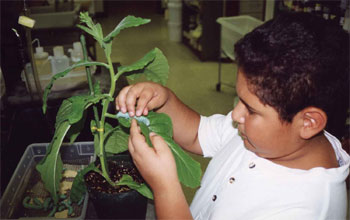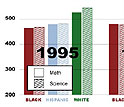News Release 04-157
International Study Shows Select Improvements in U.S. Math and Science Performance – Gains Also Seen Among Some Minority Students
U.S. blacks, Latinos show modest but significant gains at fourth and eighth grades

A third grader picks a Manduca sexta caterpillar from a tobacco plant.
December 14, 2004
This material is available primarily for archival purposes. Telephone numbers or other contact information may be out of date; please see current contact information at media contacts.
ARLINGTON, Va.— The United States made some headway against international counterparts in the 2003 Trends in International Mathematics and Science Study (TIMSS), which compares mathematics and science performance of fourth- and eighth-grade students.
The study results, released today in Boston and Washington, D.C., showed that the United States continues to score above the international average among TIMSS participants, but remains primarily in the middle of rankings among those nations that are most advanced or nations that have taken part in TIMSS consistently since the study’s first assessment in 1995. Forty-six nations participated in the 2003 study.
The 2003 study, conducted by the International Association for the Evaluation of Educational Achievement (IEA) located at Boston College, and funded by the National Science Foundation (NSF) and the Department of Education’s National Center for Education Statistics (NCES), compared fourth-grade students internationally for the first time since 1995. Eighth-grade students also participated in 1995 and 1999 studies.
Among U.S. eighth-grade students, 2003 scores in mathematics and science continued to improve, although math scores rose less. The U.S. math and science improvements, combined with decreases in average scores for some other nations placed U.S. students in a higher relative standing among its peers than in previous studies.
Fourth-grade, U.S. mathematics and science scores were virtually unchanged between 1995 and 2003. And, improvements made by other nations during that period actually lowered the relative ranking of U.S. students among TIMSS’ previous participants.
However, U.S. eighth-grade students made significant gains in mathematics scores, with noticeably better performance in algebra. Black and Latino students in math and science at both fourth and eighth grades made even more progress.
"We're pleased to note the improvements by minority students," said Arden L. Bement, Jr., NSF director. "Having access to quality teaching and challenging material in math and science can only help these students later use their acquired skills to fill opportunities in the workplace where they are most needed for the benefit of the nation.
"Previous TIMSS studies showing declining mathematics performance in middle schools seems to have engendered a response by U.S. school systems, because we now rank among the top three countries in the amount of time devoted to teaching algebra in eighth grade," Bement said. "It indicates that when concentrated attention is brought to bear on a national education problem, our school systems have the capacity to take action and get positive results."
TIMSS is considered a good tool for assessing achievement over time because it looks closely at the curricula of the participating nations, and all countries are required to draw random samples representing students and schools to participate in the study, say NSF program officials.
Some of the key findings of the 2003 TIMSS report for U.S. students in mathematics were:
- The United States maintained the same math score level among fourth-grade students as in 1995, which was above the international average but still in the middle of the group of nations that also participated in the 1995 TIMSS.
- The increased score in mathematics by U.S. eighth-grade students was greater from 1995 to 1999 than it was from 1999 to 2003, although during the 2003 TIMSS, eighth-graders showed significant improvement in performing algebra-related items.
- Eighth-grade black and Latino students continued to improve their scores in mathematics between 1995 and 2003, with blacks having the most significant increase between 1995 and 1999. Latinos continued a steadier climb throughout the eight-year period.
Some of the key findings for TIMSS 2003 in science included:
- U.S. fourth-grade students were still scoring much higher than the international average in science, and remained fifth among 15 countries that participated in both 1995 and 2003. Among U.S. students, blacks showed the most improvement.
- Eighth-grade U.S. science students not only continued to raise their overall science scores, but raised their standing among the 21 countries that participated in TIMSS in both 1995 and 2003. U.S. scoring gains from 1999 to 2003 were especially strong.
- Both eighth-grade black and Latino students increased their science scores significantly in 2003, continuing steady improvement that was also noted from 1995 to 1999. Boys and girls overall also showed modest gains between 1999 and 2003.
- U.S. students continue to score higher in life, earth and environmental sciences than in physics and chemistry.
"We should be concerned about U.S. performance in chemistry and physics, which are critical parts of basic science," said Don Thompson, NSF’s deputy assistant director for education and human resources. "But overall, TIMSS bodes well for our education system. It shows we can achieve great things when we place emphasis on and dedication to specific areas of learning. When we cast the net wider to include underrepresented minority students and others with less opportunity, we find their capacity and motivation to learn, achieve and contribute to society is strong."
-NSF-
-
Eighth-grade black and Latino student scores in the United States continue to increase.
Credit and Larger Version
Media Contacts
William C. Noxon, NSF, (703) 292-8070, email: wnoxon@nsf.gov
Program Contacts
Larry E. Suter, NSF, (703) 292-5144, email: lsuter@nsf.gov
The U.S. National Science Foundation propels the nation forward by advancing fundamental research in all fields of science and engineering. NSF supports research and people by providing facilities, instruments and funding to support their ingenuity and sustain the U.S. as a global leader in research and innovation. With a fiscal year 2023 budget of $9.5 billion, NSF funds reach all 50 states through grants to nearly 2,000 colleges, universities and institutions. Each year, NSF receives more than 40,000 competitive proposals and makes about 11,000 new awards. Those awards include support for cooperative research with industry, Arctic and Antarctic research and operations, and U.S. participation in international scientific efforts.
Connect with us online
NSF website: nsf.gov
NSF News: nsf.gov/news
For News Media: nsf.gov/news/newsroom
Statistics: nsf.gov/statistics/
Awards database: nsf.gov/awardsearch/
Follow us on social
Twitter: twitter.com/NSF
Facebook: facebook.com/US.NSF
Instagram: instagram.com/nsfgov



